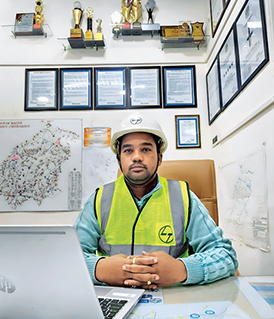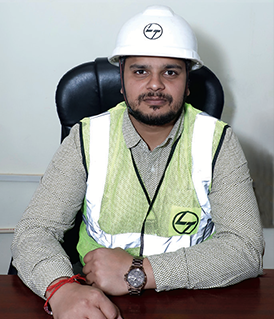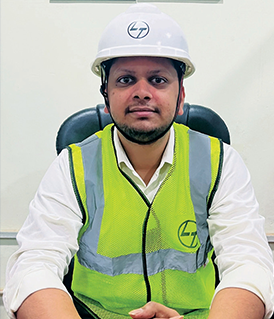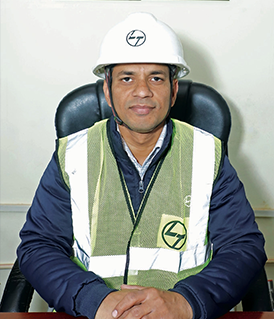
Finding innovative ways of staying safe
Silauta Mustakil & Chandi Bangar WSS

The project team standing proud with their Sword of Honour
Maintaining high EHS standards across an extensive and long project that has several inherent challenges calls for unwavering focus, precise planning, and flawless execution. The project team at the Silauta Mustakil & Chandi Bangar WSS Project in Chitrakoot, Uttar Pradesh, under the able leadership of Project Manager Rohit Sahay has successfully ticked most of the boxes, drawing accolades from all corners. While winning BSC’s Sword of Honour is a huge achievement, highlighting their innovative best practices and stringent EHS standards throughout the project lifecycle, what must have given EHS In-charge Ashif Eqbal even more joy is the fact that the project has already clocked 18 million safe manhours, putting them on a sound wicket to push forward to complete the project with a clean safety record. Certainly, winning L&T Construction’s Safety Award for 2024 is well-deserved, and yet another recognition of their excellence in operations.
Completing the long-haul safely
“We faced stiff logistical challenges when laying a pipeline network that covered an expansive area of 2,400 sq. km, much of the alignment running through densely populated urban areas,” says Rohit with a grim face. “That we successfully managed this huge task without disrupting daily life is thanks to our planning, coordination, and respect for the communities involved, always careful to minimize the impact on the local population and keep safety uppermost in everybody’s mind.”
![]()
We faced stiff logistical challenges when laying a pipeline network that covered an expansive area of 2,400 sq. km, much of the alignment running through densely populated urban areas. That we successfully managed this huge task without disrupting daily life is thanks to our planning, coordination, and respect for the communities involved.
Rohit Sahay
Project Manager
![]()


Secondary catchment arrangement for overhead tank as per SOP
Innovative construction techniques to enhance safety
With a labour force of 4,500, it was essential for the site leadership to find and adopt innovative construction methods that reduced human risk, and one such was resorting to Advanced Monolithic Formwork (AMF), which enhanced safety as well as the durability and efficiency of the overhead water tanks. “While AMF reduced the physical risks to workers, particularly in tasks that involved heavy lifting and working at height, the technique significantly reduced intensive labour, manual interventions, and the risk of injuries due to heavy lifting or repetitive tasks, thereby helping to create a safer work environment,” explains Planning Incharge Aman Jain. “Workers had to work less at height, which dramatically reduced their exposure to work-at-height risks,” smiles Aman.
![]()
While AMF reduced the physical risks to workers, particularly in tasks that involved heavy lifting and working at height, the technique significantly reduced intensive labour, manual interventions, and the risk of injuries due to heavy lifting or repetitive tasks, thereby helping to create a safer work environment.
Aman Jain
Planning In-charge
![]()

What the project team found even more beneficial is that AMF helped to speed up construction timelines in comparison to traditional methods, improve seismic resistance and structural performance during earthquakes, resulting in a stronger and more stable integrated structure with reduced risk of collapse, addressing one of the major safety concerns in conventional construction methods.
Innovative initiatives such as the installation of paver blocks for water percolation in the ground and the widespread adoption of energy-efficient LED lighting have minimized environmental impact at the project. “Our use of Variable Frequency Drive panels to optimize energy consumption for pumping operations has resulted in substantial energy savings, which has strengthened our promise of sustainability to Mother Earth,” Aman Agarwal, 2ndLine EHSO, expresses with a smile.
![]()
Our use of Variable Frequency Drive panels to optimize energy consumption for pumping operations has resulted in substantial energy savings, which has strengthened our promise of sustainability to Mother Earth.
Aman Agarwal
2nd-Line EHSO
![]()

Staying safe underwater
A particularly challenging task for the project team was to safely sink the stuck Chandi Bangar intake well, which involved diving operations. “It was tough because the conditions were unfavourable for us with weathered rock, boulders, and a continuous water flow,” shares Ashif. “In fact, during execution, our soil grab bucket got stuck,” he recalls, shaking his head, “but we are thankful to our EHS Head, K Sudheesh Kumar, who personally visited the site to lead and guide us during this difficult operation.”
![]()
I am delighted to state that this underwater operation was a true testament to the project team’s problem-solving ability and resilience, especially in a situation in which traditional methods might not have been effective or safe, always strictly following safety protocols.
K Sudheesh Kumar
Head – EHS, WET IC
![]()

Sudheesh adds that the team mitigated the risk of underwater operations by using specialized equipment, ensuring that only trained divers were pressed into action. “I am delighted to state that this underwater operation was a true testament to the project team’s problem-solving ability and resilience, especially in a situation in which traditional methods might not have been effective or safe, always strictly following safety protocols.”

The BSC team conducting their 5‑Star Audit at the site
Keeping their workers safe & motivated
Prioritizing the well-being and engagement of the 4,500 workers has been another critical aspect of the project’s success thus far,” notes Rohit, “by focusing on both their physical and mental health through wellness programmes like health check-ups, mental well-being sessions, and safety awareness initiatives.” The result has been an engaged, motivated, and fit workforce with high morale, carrying out their tasks efficiently and productively. Ashif mentions introducing the orange helmet initiative for new workers and using pictorial, easy-to-understand OCPs. “Our Zero Tolerance Card programme and regular emergency preparedness drills are keeping workers vigilant and committed to our safety standards,” he adds with determination.
![]()
Our Zero Tolerance Card programme and regular emergency preparedness drills are keeping workers vigilant and committed to our safety standards.
Ashif Eqbal
EHS In-charge
![]()


Recreational activities for workers
Technology, an able ally
Digital monitoring systems, geofencing, and IoT solutions are driving quality and safety. “We can track project progress and safety compliance in real time, which is helping to both minimize risks and improve efficiency,” remarks a pleased Rohit. By prioritizing local hiring and creating jobs, the project is building goodwill within the community, which is also aiding them in their speedy execution. Awareness campaigns keep the locals informed about the project’s intent, progress, and timelines, while initiatives to improve health, education, & infrastructure are further strengthening their connect.
Although challenges remain, Rohit and his enterprising team are collaboratively doing all that it takes and more to ensure that their project moves quickly to completion, keeping their innovative juices flowing, maintaining their operational efficiency, and never losing sight of their EHS commitments.